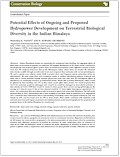| Journal Article |
 |
|
| Article Title | Potential Effects of Ongoing and Proposed Hydropower Development on Terrestrial Biological Diversity in the Indian Himalaya | | Author | Maharaj K. Pandit and R. Edward Grumbine | | Year | 2012 | | Journal Title | Conservation Biology | | Institution | Society for Conservation Biology | | Volume | 26 | | Issue | 6 | | Pages | 1061–1071 | | Call Number | JA0514-14 | | Keywords | dams, land-cover change, land-use change, species extinction, species richness |
|
| Abstract: |
| Indian Himalayan basins are earmarked for widespread dam building, but aggregate effects of
these dams on terrestrial ecosystems are unknown. We mapped distribution of 292 dams (under construction
and proposed) and projected effects of these dams on terrestrial ecosystems under different scenarios of landcover
loss. We analyzed land-cover data of the Himalayan valleys, where dams are located. We estimated
dam density on fifth- through seventh-order rivers and compared these estimates with current global figures.
We used a species–area relation model (SAR) to predict short- and long-term species extinctions driven by
deforestation. We used scatter plots and correlation studies to analyze distribution patterns of species and
dams and to reveal potential overlap between species-rich areas and dam sites. We investigated effects of
disturbance on community structure of undisturbed forests. Nearly 90% of Indian Himalayan valleys would
be affected by dam building and 27% of these dams would affect dense forests. Our model projected that
54,117 ha of forests would be submerged and 114,361 ha would be damaged by dam-related activities. A
dam density of 0.3247/1000 km2 would be nearly 62 times greater than current average global figures; the
average of 1 dam for every 32 km of river channel would be 1.5 times higher than figures reported for U.S.
rivers. Our results show that most dams would be located in species-rich areas of the Himalaya. The SAR model
projected that by 2025, deforestation due to dam building would likely result in extinction of 22 angiosperm
and 7 vertebrate taxa. Disturbance due to dam building would likely reduce tree species richness by 35%, tree
density by 42%, and tree basal cover by 30% in dense forests. These results, combined with relatively weak
national environmental impact assessment and implementation, point toward significant loss of species if all
proposed dams in the Indian Himalaya are constructed. |
|
|
Download file(s): Click icon to download/open file.
|
| |
File Size |
Description |

|
1,028 KB |
Softcopy |
|
|
|
| Viewed in 1249 times. Downloaded in 775 times. |